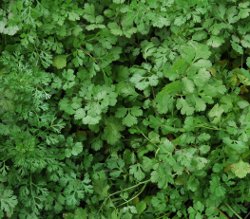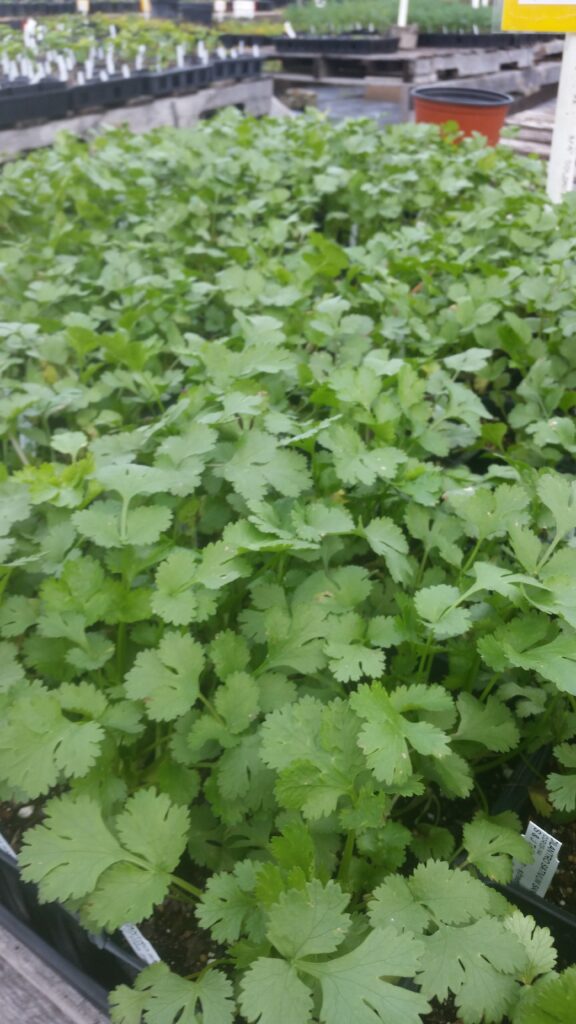Growing Cilantro and Coriander in Northeast Florida Gardens
(Coriandrum sativum)
Cilantro Herb Plants / Coriander sativum For Northeast Florida Origins:

The plant that has two names. As if there isn’t enough confusion between plant cultivars already, we have chosen to call this plant by one name when referring to it’s foliage, and by another name when referring to its seeds. Then there are different hybrids of each, which are all called by different names. Add to that the fact that you will sometimes find Cilantro being grown as ‘Chinese Parsley’ and you have just got a big mess on your hands trying to deicide what plant is what.
So let me simplify, Coriander and Cilantro are the exact same plant. Thank heavens for botanical plant names! ‘Coriander Sativum’ is referred to as Cilantro when we talk about the foliage of the plant and it is referred to as Coriander when we talk about the seeds of the plant. There are different hybrids available, but all can be harvested as Cilantro leaves and as Coriander seeds.
Regardless of what you call it, Cilantro / Coriander Sativum is a highly prized herb native to the Eastern portions of the Mediterranean. History shows Europeans have used the seeds and leaves for culinary purposes all the way back to Medieval times. Today, Cilantro is a staple in Mexican cuisine and most often used here in America in the preparation of Salsa. Coriander is indispensable in Indonesian cuisine as it is an important ingredient in curry powders.
Cilantro / Coriander Sativum Growing Season for Northeast Florida:
Cilantro / Coriander sativum grows great in Florida year round. Cilantro herb plants grown to harvest their leaves are best planted in the cooler seasons of the Northeast Florida/ Jacksonville and St. Augustine area gardens. Think of them as you would lettuce, or collard greens, and plant them in the fall or early spring.
The Cilantro plant will quickly bolt and grow to seed when soil temperatures rise above 80 degrees. So when planting Cilantro in summer months you may find it easier to just let the plants go to seed and harvest your Coriander seeds.
Plant from seeds in fall at least 60 days before the first frost (October/November), or in early spring (February)for best results.
Sun Exposure for Cilantro / Coriander Sativum in Northeast Florida:
Plant Cilantro / Coriander Sativum in full sun, or partial shade.
Soil Preference for Cilantro / Coriander Sativum:
Cilantro / Coriander Sativum is an easy to grow annual Herb. Amend your planting site generously with compost when installing your new Cilantro / Coriander Sativum plants and each year in the early spring when keeping plants for more than one season.
Water and Fertilizer Requirements of Cilantro / Coriander Sativum Herb Plants:
Newly planted seeds will require watering every day until the set of mature leaves emerges, then taper back to three times a week, then twice a week for in-ground plants and three to four times a week for plants potted in containers.

In General, Herbs need little fertilizer. To much fertilizer can lead to lush green growth with low volitale oils in the plant, less oils equals less flavor and aroma for your herbs. However, when planting into Floridas sandy soils you may find your plants in need of a boost. If so, try fertilizing with a mixture of organic fish emulsions and seaweed at one ounce of each per gallon of water. Put into a sprayer and water every other week or as needed with the mixed solution. If your leaves still look a bit lackluster consider a bit of blood meal fertilizer.
Or, if you find your plant struggling at any point, make up a batch of compost tea and water generously. Repeat as needed weekly or biweekly.
Size of Cilantro / Coriander Sativum When Mature:
Cilantro/ Coriander sativum plants quickly grow to 12-18 inches high and 8-12 inches wide.
Sowing Cilantro / Coriander Sativum Seeds into Northeast Florida Soils:
Cilantro / Coriander Sativum seeds are hard and may need soaked overnight, cracked or scarified before planting.
Harvesting Your Cilantro / Coriander Sativum in the Northeast Florida Landscape:
Cilantro is best used fresh, harvest the plant’s outer leaves when it is as small as 6 inches high, and harvest the entire plant when flower stalks begin to form for Cilantro leaves. If harvesting coriander seeds, allow your flowers to grow and seeds to set.
Blooms and Seeds of Cilantro / Coriander Sativum for Northeast Florida Landscape:
Cilantro plants quickly bolt with Florida’s hot temperatures. The flowers are held just a few inches above the lacelike foliage and are somewhat decorative.
Seeds are small and rounded and have a hard outer shell.

